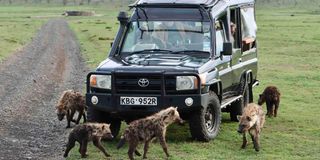A curious clan of hyenas

Inquisitive hyenas encircling a safari vehicle in Ol Pejeta.
Does ‘chewed by a hyena’ count as vandalism? I had lots of insurance questions as I watched a cheeky hyena gnaw on my protruding fender mirror. Others nibbled at my bumper, and bit chunks of mud off my caked tyres.
We found these inquisitive (and destructive) young hyenas on a plain in the heart of the Ol Pejeta Conservancy. They poked their heads out of their communal dens as we approached and quickly scampered over to investigate.
On the edge of one of the dens, a mother nursed a couple of jet-black cubs, while some other youngsters squabbled over a buffalo rib nearby.
Spotted hyenas have an unfair reputation as dim-witted, laughing scavengers. Hemingway described them as ‘hermaphroditic self-eating devourer(s) of the dead’. But through spending time with them on safari, it doesn’t take long to realise that they are actually incredibly smart and socially complex creatures. (Although that one cub didn’t look very intelligent as he chewed on my mirror.)
While hyenas also usually hunt a lot of their own prey, there has been plenty of food for them to scavenge in Ol Pejeta as a result of the recent drought. The conservancy’s buffaloes seemed to have suffered the most; we came across over a dozen carcasses on our game drives.
But the landscape is now green and teeming with life, thanks to the long overdue arrival of rain over the last few weeks. Elephants grazed in the marshes and on most plains, the majority kicking up clumps of grass with their feet and shovelling them into their mouths as we passed by. We spotted lots of rhinos, too, including a couple of black rhinos within dense patches of euclea shrubs.
At the end of our evening game drive, we encountered a herd of elephants moving gracefully across an open plain. They were lit by the low, setting sun, but the sky behind them was dark and ominous. We watched a grey sheet of rain sweep across the east of the conservancy, right above our campsite.
Back in camp, the rain had stopped and we were welcomed by a chorus of frogs and guinea fowl. We had chosen the Ewaso Campsite, one of the five camping areas in the conservancy. It’s a very tranquil spot on a wide bend of the Ewaso Nyiro River within a fenced-off ‘exclusion zone’.
As part of their habitat recovery programme, Ol Pejeta protects sections of riverine vegetation from damage by elephants and other large wildlife. An electric fence keeps these animals out (most of the time), to allow replanted indigenous trees to grow.
The nearby Ol Lerai and Hippo Hide Campsites are also on the banks of the Ewaso Nyiro River. Murera Donga is by a marsh further north while the Mbogo Campsite is in a remote location in the larger western section of the conservancy. All of the campsites have toilet facilities and are supplied with firewood and a water bowser.
As the last of the day’s light filtered away, we sat by a fire on the bank of the river and listened to the sounds of the bush. A congregation of weaverbirds still chattered in their nests, which hung precariously above the water. They were disrupted by a sudden loud crunch on the opposite bank: an elephant browsing in the dense vegetation.
The snapping of branches and chewing of grass went on for a while until we realised it was coming from our side of the river. I flashed my torch into the darkness behind me, startling a couple of buffaloes grazing just a few metres away. They crashed off into the bush, but we heard them chomping around our tent throughout the night.
These are the thrills of camping in wild spaces like Ol Pejeta. You can also have the security of an armed ranger for Sh5,000 per night. The camping fee is Sh2,600 each for adults on top of a conservation fee. For more information, head to www.olpejetaconservancy.org.
Email: [email protected]





